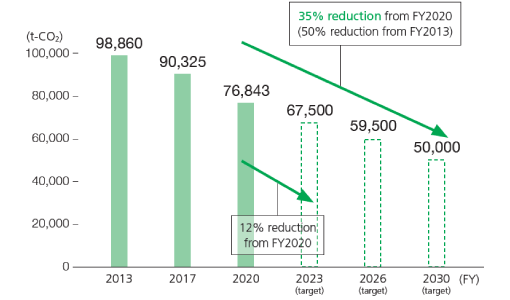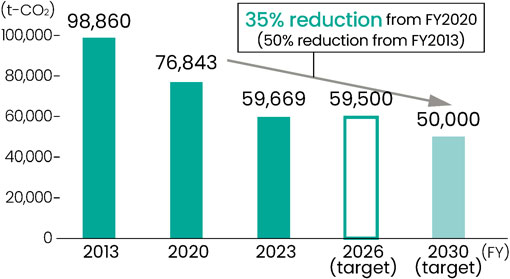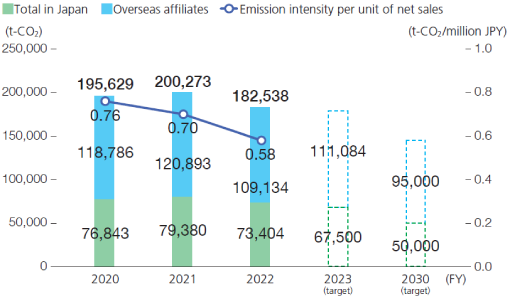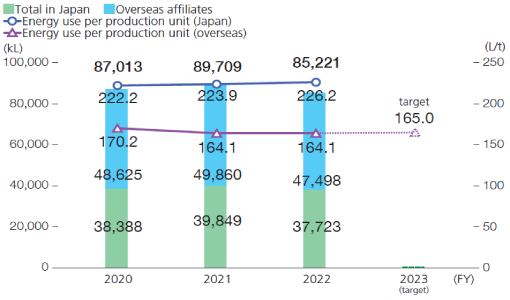Response to Climate Change
- Basic approach
- Targets and achievements
- CO2 Emissions in the Supply Chain
- Third-party verification of CO2 emissions data (Japan)
- Compliance with TCFD
Basic approach
Climate change caused by global warming, caused by an increase in global greenhouse gas (GHG) emissions, is one of the most important issues facing global society. artience group recognizes that addressing climate change is an important management issue that has a significant impact on corporate activities, and in November 2020 announced its support for the Task Force on Climate-related Financial Disclosures (TCFD). Currently, based on the Sustainability Vision ASV2050/2030, which is the core of the Group's sustainability strategy, we are promoting climate change response activities such as reducing CO2 emissions to achieve carbon neutrality by 2050, and disclosing information in accordance with the TCFD recommendations on our website and in various reports.
Targets and achievements
Targets
Since the launch of the CO2 Reduction Project in fiscal 2010, the Group has been working to reduce CO2 emissions at its production sites in Japan and overseas.
The Sustainability Vision ASV2050/2030 declares that the Group will achieve carbon neutrality by 2050 regarding CO2 emissions from its production activities.
In addition, we have set specific interim targets of reducing CO2 emissions by 35% in Japan by FY2030 compared to FY2020 (target value of 50,000 tons) and overseas by 35% reduction compared to FY2030 BAU (target value of 95,000 tons).
In order to achieve these goals, we are taking various measures in three directions: reducing energy consumption, low-carbon energy, and low-carbon electricity. In Japan, where many cogeneration systems are in operation at production sites, we will focus on low-carbon energy by switching to low-carbon fuels used in systems and promoting the electrification of production facilities. On the other hand, in overseas countries, where the electrification of production facilities is relatively advanced, we will focus on low-carbon electricity, such as using renewable energy for electricity.
Goals for material issues (material issue 2)
artience Targets for 2027 (FY2024~FY2026)
CO2 Emissions Reduction Targets for ASV2050/2030
In asv2030, we have set targets for reducing CO2 emissions (in Japan) by 35% compared to FY2020 to 50,000 tons, and CO2 emissions (overseas) by 35% compared to BAU in FY2030 to 95,000 tons. In order to achieve this, we will take various measures in the three aspects of "reducing energy consumption," "low-carbonization of energy," and "low-carbonization of electricity" with the aim of further reduction.
CO2 Emissions (Domestic) Trends and Targets






| Direction | Main measures |
|---|---|
| Reduce energy usage | ・Energy saving (Elimination of energy loss during the process) ・Reform of production processes from the perspective of energy conservation |
| Low carbon energy | ・Electrification of production equipment (reduction of direct emissions) ・Preparation and research for the use of LNG alternative fuels |
| Low-carbon electricity | ・Introduction of low-carbon electricity (reduction of indirect emissions) ・Introduction of renewable energy facilities |
Fiscal 2023 Results
CO2 emissions
In fiscal 2023, the total volume of the Group was 159,571 tons (down 13.9% from the previous year), a decrease from the previous fiscal year both in Japan and overseas. This was due to a decrease in production volumes, changes in production items, and efforts to reduce CO2 emissions.


Scope of calculation: All domestic bases and major overseas production affiliates
- For CO2 emissions related to electricity (domestic), emissions coefficients for each electricity company published each year are used.
- CO2 emissions related to electricity (overseas) are calculated using country-specific emission factors listed in the IDEA database.
Energy usage
In fiscal 2023, the total volume of sales for the entire Group was 74,106 kL (down 13.0% from the previous year), a decrease compared to the previous fiscal year both in Japan and overseas. This is due to a decrease in energy usage due to a decrease in production. Energy intensity (the amount of energy required to produce 1 ton of product) decreased slightly due to a decline in the operating rate and changes in production items.


Scope of calculation: Domestic major manufacturing facilities/factories and domestic affiliated companies; overseas, major overseas production affiliated companies.
CO2 Emissions in the Supply Chain
CO2 emissions associated with business activities from upstream to downstream of the supply chain were calculated in accordance with the Basic Guidelines for Calculating Greenhouse Gas Emissions Throughout the Supply Chain.
For upstream and downstream emissions in the supply chain (Scope 3), we calculated 12 of the 15 categories indicated in the Basic Guidelines. For the processing, use, and disposal of sold products (Categories 10, 11, and 12), we did not calculate the entire calculation range due to the wide range of products and the difficulty of identifying scenarios for processing, use, and disposal of sold products. In fiscal 2023, we expanded the scope of aggregation to include overseas bases, which were previously excluded from the calculation. Going forward, we will continue to improve the accuracy of aggregation and collaborate with suppliers to reduce CO2 emissions.


Third-party verification of CO2 emissions data (Japan)
artience Co., Ltd. has undergone third-party verification of Scope 1 and 2 greenhouse gas (CO2) emissions at all sites in Japan.
Compliance with TCFD
In November 2020, we endorsed the TCFD (Task Force on Climate-related Financial Disclosures). We will enhance and accelerate our environmental initiatives, including measures to address climate change, and promote information disclosure in line with TCFD recommendations.
Information Disclosure Based on TCFD Recommendations
- Introduction of cogeneration system
- Implementation of Air Leakage Reduction Activities
- Renewable Energy Initiatives
- Climate Change Initiatives
